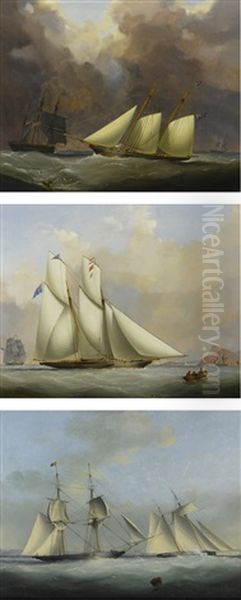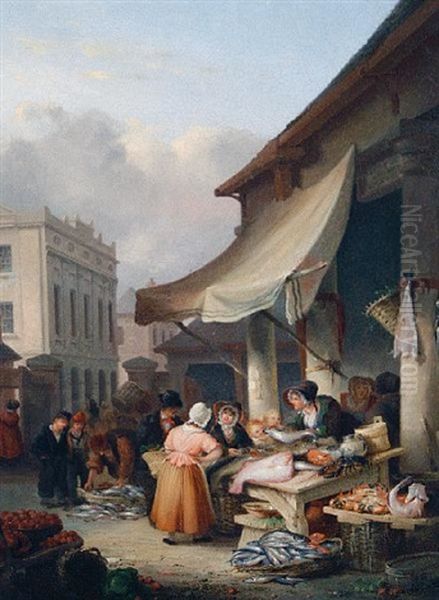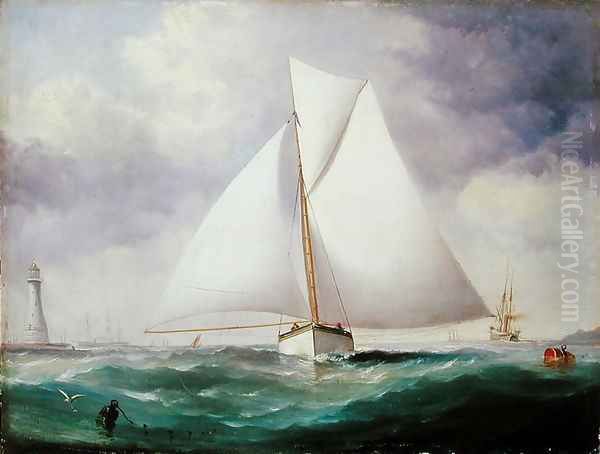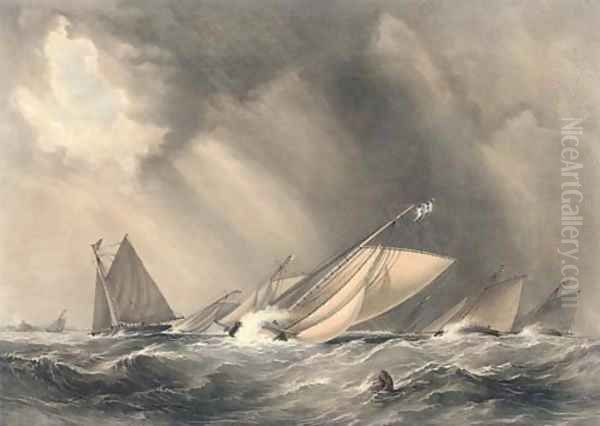Nicholas Condy, a notable figure in 19th-century English art, carved a distinguished career through his evocative landscapes, detailed architectural studies, dynamic marine scenes, and insightful portraits. Born in Torpoint, Cornwall, in 1793, his life journeyed from military service during a tumultuous period of European history to the dedicated pursuit of art, leaving behind a legacy of works that capture the essence of his era, particularly the maritime and rural character of England's southwest. He passed away in Plymouth in 1857, recognized for his skill in both oil and watercolour.
Early Life and Military Interlude
The formative years of Nicholas Condy were set against the backdrop of the Napoleonic Wars, a series of major global conflicts pitting the French Empire and its allies, led by Napoleon I, against a fluctuating array of European powers. In 1811, at the age of approximately eighteen, Condy joined the army. This was not an uncommon path for young men of the time, but for an aspiring artist, it offered a unique, if harsh, school of observation.
His military service saw him participate in the Peninsular War, a brutal and protracted conflict fought on the Iberian Peninsula, where Spanish, Portuguese, and British forces battled Napoleon's armies. This campaign, lasting from 1807 to 1814, was characterized by grueling marches, sieges, and pitched battles across varied and often dramatic terrains. While specific details of Condy's individual engagements are not extensively documented, his presence in Spain and Portugal during this period would have exposed him to landscapes, human drama, and scenes of maritime activity that could have profoundly influenced his later artistic vision. The discipline of military life, the keen observation required, and the exposure to diverse environments may well have honed skills that would later serve him as a painter. He remained in military service until 1818, retiring with a pension that perhaps provided a degree of stability as he transitioned into a new chapter of his life.
The Emergence of a Professional Artist

Upon leaving the army, Nicholas Condy established himself as a professional artist, choosing Plymouth as his primary base of operations. This bustling port city in Devon, with its rich maritime heritage and picturesque surroundings, offered a wealth of subject matter. Condy's decision to pursue art professionally marked a significant shift, channeling the experiences and observational skills from his military years into a creative outlet.
He became proficient in both oil painting and watercolour, two mediums popular in 19th-century Britain. Oils allowed for rich depth, texture, and luminosity, ideal for formal portraits and substantial marine or landscape compositions. Watercolours, with their translucency and immediacy, were perfectly suited for capturing the fleeting effects of light and atmosphere, particularly in landscapes and topographical views, a genre at which British artists excelled. Condy's versatility across these mediums enabled him to tackle a wide range of subjects and commissions.
His reputation began to grow, and by the 1830s, his works were being exhibited in London, the epicenter of the British art world. Inclusion in exhibitions, particularly at prestigious venues like the Royal Academy of Arts, was crucial for an artist's career, offering visibility, critical appraisal, and opportunities for patronage. The Royal Academy, founded in 1768 with Sir Joshua Reynolds as its first president, was the paramount institution for art in Britain, and exhibiting there signified a certain level of professional achievement.
Marine Paintings: A Defining Genre
Given his base in Plymouth, a major naval port and hub of maritime activity, it is unsurprising that marine painting became a significant part of Nicholas Condy's oeuvre. His military background, possibly involving coastal or naval interactions, combined with his daily exposure to the ships and seascapes of the Devon coast, provided him with an intimate understanding of his subject.
His marine works often depicted vessels with accuracy and a keen eye for nautical detail. Paintings such as "Royal Yacht 'George IV' berthed at Plymouth" exemplify his ability to capture the grandeur of significant ships within their specific settings. Such pieces were not merely representations of boats but also documents of maritime power, leisure, and commerce. Another notable work, "H.M.S. Britannia entering Plymouth Sound," showcases his skill in rendering the imposing presence of naval vessels, a subject of great national pride in 19th-century Britain. The accuracy in rigging, hull design, and the depiction of ships in various weather conditions would have been appreciated by a public familiar with maritime life.

Condy's marine art can be seen in the context of a strong British tradition of marine painting, which included artists like Charles Brooking from an earlier generation, and contemporaries such as Clarkson Stanfield and Edward William Cooke, both of whom were highly regarded for their dramatic and accurate seascapes. While J.M.W. Turner, a towering figure of the era, often used marine subjects for his sublime and atmospheric explorations of nature's power, Condy's approach, though skilled, often leaned towards a more detailed and descriptive representation, valued for its clarity and fidelity. Other marine painters of the period, like George Chambers Sr. and William John Huggins, who was Marine Painter to King William IV, also contributed to this rich genre, each with their individual styles. Condy's work, "Ships off Devonport," now in the National Maritime Museum in London, is praised for its precise depiction of ship structures.
Further examples of his marine subjects include "The Marine Sale," depicting a French lugger sailing away from a French warship, and "The Post Office Packet Shelldrake off Falmouth," capturing the vital communication links of the era. His painting of the yacht "Ganymede" and the historical scene "Brig The Water Witch," associated with Henry Bradley, further illustrate his engagement with specific vessels and their stories. The work "Pantaloons," dated 1831 and depicting the titular ship, is held in the National Archives of Singapore, indicating the reach and preservation of his art.
Landscapes and Architectural Views
Beyond the sea, Nicholas Condy was an accomplished painter of landscapes and architectural scenes. His works in this domain often focused on the estates and scenic views of Devon and Cornwall, reflecting the Picturesque sensibilities prevalent in the 19th century. This movement valued landscapes that were visually charming, varied, and suitable for artistic representation.
A significant portion of his work in this area is associated with Mount Edgcumbe House, a grand stately home situated on the Rame Peninsula in southeast Cornwall, overlooking Plymouth Sound. Condy produced numerous views of the estate, including the notable "Mount Edgcumbe House, 1849." These paintings would have captured not only the architectural features of the house but also its beautifully landscaped gardens and the surrounding natural beauty, often imbued with a sense of tranquility and classical order. His involvement with Mount Edgcumbe extended to interior scenes, such as "Estate Workers in the Kitchen Interior, 1793" and "Estate Employees in the Servants' Hall, 1857," offering fascinating glimpses into the social fabric and daily life of a large estate. He was also involved in some of the decorative design work at the estate, showcasing another facet of his artistic talents.
His architectural interests are further evidenced by a court dinner painting created for Cotehele House, another historic property in Cornwall. Works like "Plymouth Fish Market" demonstrate his ability to capture bustling urban scenes, blending architectural elements with genre details. This painting is considered an important topographical view of Plymouth. The mixed-media piece "On the Dart" suggests his exploration of different techniques to render the varied landscapes of the region.

In the broader context of British landscape and architectural painting, Condy worked during a period of immense talent. John Constable was revolutionizing landscape art with his naturalistic depictions of the English countryside, while Samuel Prout was renowned for his detailed watercolour drawings of European architecture. David Roberts gained fame for his views of the Near East and architectural subjects. While Condy's focus was more regional, his work shared the era's appreciation for specific locations and their characteristic features.
Portraiture and Patronage
Nicholas Condy also undertook portrait commissions, a staple for many artists seeking to secure a livelihood. His most prominent patrons in this regard were the Earls of Edgcumbe. He painted portraits of both the 2nd and 3rd Earls of Edgcumbe, figures of significant local and national standing. These portraits would have served not only to record their likenesses but also to affirm their status and connection to their ancestral home, which Condy so frequently depicted.
Patronage was a critical element of an artist's success in the 19th century. Aristocratic families like the Edgcumbes, and figures such as the Earl of Egremont (who was a noted patron of J.M.W. Turner and also appreciated the work of Condy's son), played a vital role in supporting the arts. Their commissions provided artists with income and often led to further opportunities. Condy's relationship with the Earls of Edgcumbe appears to have been particularly fruitful, resulting in a body of work that documents their estate and family.
The ability to capture a likeness while also conveying something of the sitter's character or station was paramount in portraiture. Artists like Sir Thomas Lawrence, who dominated British portraiture in the early part of the century, set a high standard for elegance and psychological insight. While Condy was not primarily a portrait specialist in the same vein, his contributions in this genre were an important part of his versatile output.
Exhibitions, Recognition, and Teaching
As mentioned, Nicholas Condy's works were exhibited in London from the 1830s, including at the Royal Academy. This exposure was vital for building a reputation beyond his local sphere. The Royal Academy's Summer Exhibition was, and remains, a major event in the art calendar, attracting submissions from established Academicians (like Stanley Clark RA, mentioned as a contemporary, though "Stanley Clark RA" is not a widely recognized historical RA of that exact name and period, perhaps referring to someone like Clarkson Stanfield RA, or it's a more obscure reference) and aspiring artists alike. Other venues in London also provided platforms for artists to showcase their work.

His contemporary, Robert Charles Leeson Rowbotham, was part of a family of watercolour painters, and their work, like Condy's, often featured landscapes and coastal scenes, reflecting popular tastes. The art world of the time was a network of societies, exhibitions, and personal connections. Condy's participation in this world, evidenced by his London exhibitions, indicates his ambition and the recognition he achieved.
Beyond his own practice, Condy also engaged in teaching. It is recorded that he taught painting to a Mrs. Collins, suggesting he shared his knowledge and skills with pupils, contributing to the artistic education of others in his community. This role as an instructor, however informal, was common for established artists.
The Condy Artistic Lineage: Nicholas Matthews Condy
It is important to distinguish Nicholas Condy (1793-1857) from his son, Nicholas Matthews Condy (1816-1851), who was also a talented painter, particularly known for his marine subjects. The son, sometimes referred to as "Nicholas Condy the Younger," unfortunately had a much shorter life but achieved considerable recognition for his maritime art.
Nicholas Matthews Condy's work was reportedly admired by the Earl of Egremont, a significant connoisseur and patron. The younger Condy specialized in highly finished, detailed paintings of ships and coastal scenes, often on a smaller scale than his father's work. His paintings are prized for their meticulous execution and vibrant depiction of naval and yachting subjects. The shared name and specialization in marine art can sometimes lead to confusion, but their careers, while overlapping, were distinct. The father had a longer and perhaps more varied career in terms of subject matter, encompassing landscapes and portraits more broadly, in addition to his marine work. The son's focus was more intensely on the maritime.
The provided information mentions that Nicholas Condy (presumably the father, though some biographical details can blur between father and son in various sources) attended Mount Radford School in Exeter and received drawing lessons from a Reverend C. Thomas. If this refers to the elder Condy, it would point to some formal art instruction in his youth, prior to his military service.
Later Life and Enduring Legacy
Nicholas Condy continued to paint throughout his life, based primarily in Plymouth. He died in 1857 and was buried in the churchyard of St. Andrew's Church, Plymouth. His death marked the end of a career that had diligently chronicled the landscapes, maritime life, and notable figures of his region.

His legacy endures through his artworks, many of which are held in public and private collections. Works like "The Spinnaker Sail," located in the Royal Albert Memorial Museum in Exeter, and his paintings at Mount Edgcumbe House, continue to be appreciated. His depictions of specific ships, such as "Lord Belfast's yacht Galatea," provide valuable historical records of maritime design and activity.
Condy's art offers a window into 19th-century Britain, particularly the southwest of England. His paintings reflect the pride in naval power, the appreciation for picturesque landscapes, and the social structures of the time. He was a versatile artist who, while perhaps not as revolutionary as some of his more famous contemporaries like Turner or Constable, possessed considerable skill and a keen eye for detail. His contribution lies in his faithful and aesthetically pleasing documentation of his world. He worked within established traditions of British painting, but brought his own unique experiences, including his military service, to bear on his subjects.
His contemporaries included a wide array of talents. Beyond those already mentioned, artists like Augustus Wall Callcott (known for landscapes and marine views), Thomas Luny (an earlier but highly prolific West Country marine painter whose influence might have been felt), and even the architectural precision of someone like Frederick Mackenzie, all contributed to the rich artistic tapestry of the era. Condy's work finds its place within this vibrant scene as a skilled practitioner who captured his chosen subjects with dedication and artistry.
Conclusion
Nicholas Condy (1793-1857) stands as a significant provincial English artist of the 19th century whose diverse body of work provides a rich visual record of his time. From his early experiences in the Napoleonic Wars to his established career as a painter in Plymouth, Condy developed a versatile skill set that allowed him to excel in marine painting, landscape, architectural views, and portraiture. His meticulous attention to detail, particularly in his maritime subjects and depictions of local estates like Mount Edgcumbe, has ensured the lasting value of his work both as art and as historical documentation.

While operating somewhat outside the main currents of avant-garde art in London, Condy's consistent output, his exhibitions at the Royal Academy, and his connections with important patrons underscore his professional standing. He captured the spirit of England's southwest, its naval prowess, its scenic beauty, and its social life, with an honest and skilled hand. His paintings remain a testament to a dedicated artistic career and offer enduring insights into the world he inhabited, securing his place in the annals of British art.